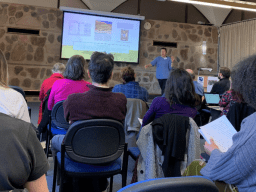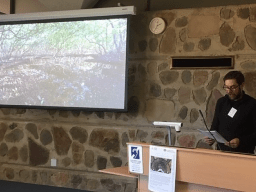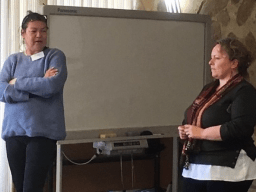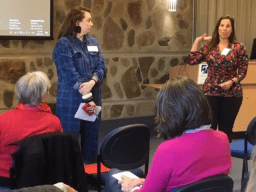Opening slide of Keynote by Donovan Schaefer
The Sacred Histories Symposium, held on Friday 23 August, was co-hosted between the Rediscovering the Deep Human Past ARC Laureate Program (ANU) and the Faculty of Arts at Macquarie University; co-convened by Dr Laura Rademaker (ANU) and Associate Professor Clare Monagle (Macquarie). The symposium set as its ambitious aim “to highlight the importance of recognising experiences that subjects experience or know as ‘sacred’ in the historical record”, and in particular to experiment with “dangerous” or “radically cross-cultural histories” in which the sacred might illuminate the “histories of different peoples and places”.
Ultimately, the symposium would not deliver its aim – for it rarely attempted a definition of the sacred, nor its embodiment in practice, and said little that was cogent about the history of (forms of) the sacred as such – but it did deliver something equally provoking and important: how contestations over the sacred– be it sacred ground, sacred buildings, sacred trees, sacred people or gods etc. – was a schematic of colonial encounters and a propaedeutic for historical discourse. In this context, what the symposium actually materialised was not a deeper understanding of the sacred, but rather how the power-relations inherent in competing views of the sacred are manifested in time – and primarily within colonial time – and, importantly, begged the question of the “sacred” right to theorize about “the other” from the position of oneself.
It is important to note that Len Collard and Laura Rademaker were unable to attend; their late (unexpected) withdrawals no doubt had an impact on the proceedings.
But despite not bringing the sacred any closer to comprehension as such (i.e. as a felt or explicitly defined aspect of experience), the symposium presented nuanced and intelligent papers on the contestations of the sacred in time; and the forthright question-and-answer sessions left none in doubt that sacred sensitivities had been breached!
The keynote speaker, Donovan Schaefer, delivered a sermon on the “schisis” (schism) of religion and secularism in late 17th century based on the construction of the Sheldonian Theatre in Oxford, to excise rowdy disputations from the sombre surrounds of the University Church of St Mary the Virgin – a schisis whose foundation was one predominantly of affect: of a variation in emotions pertaining to the sacred, and a desire to keep them separate.
The theme of (schism of) sacred affect would permeate the symposium: Notre Dame’s burning and the multi-million dollar pledges for its immediate reconstruction was compared to the (slated) destruction of the Djab Wurrung trees near Ararat for the construction of a highway, which has gone almost unnoticed (Clare Monagle); the stability of Nyungar virtues in deep time, demonstrated to descend from sacred Nyungar knowledge (Aileen Walsh), formed a stark contrast to the capitalist juggernaut which has destroyed the planet’s ecosystem in mere centuries; while the “encounter of laws” – that of Aboriginal law derived from country and monotheistic law inherent to Christianity – produced a torrid colonial frontier experience of contested sacrality (Joanna Cruickshank), one whose reconciliation Katherine Massam considered possible - at least at a local level - through collaborative liturgical expression of the memory of the death and rebirth of Jesus and the palliative of syncretic religion.
The symposium closed with a lively presentation by Shannon Foster, whose presentation title – the “Rematriation of her story” – pointed directly to the schism it intended to address: the inequity of gender relations, a fight for the female voice which became, ultimately, a fight for the substantive earth (Mother Earth). This was followed by a showing of the short film Devil’s country (Juanita Ruys). The film opened with a white, British ultra-marathon-runner admitting he was perennially afraid of the Australian bush, and closed with a barrage of questions and comments from the symposium audience – particularly its non-Caucasian members – about appropriate engagement with Indigenous people in the production of documentary items (be they writing, video, sound, art, etc.) containing their voices and, by implication, their view of the sacred.
That schism would be the predominant theme in a symposium supposedly about the sacred is curious, but not unexpected: be it based on emotions (affect) or concepts, the experience and expression of the sacred comes out differently for different people and different cultures – which is what gives the sacred its historical trajectory (and, perhaps, its actual sacrality). Syncretism notwithstanding it is hard to fold the forms of the sacred into one another, and it is hard to fold them together into a conception of the sacred in general, or into a history without antinomies. This leaves one wondering whether reconciliation between factions of the sacred is, in fact, possible at all, or if the history of the sacred will not turn necessarily into histories of power relations.
This would be too defeatist (and too Marxist?), however, and is not what the symposium intended. Ultimately, new conceptions of history are required (probably ones that deal with the constitutive aspects of the sacred in experience itself) that escape the regress into a descriptive of power dynamics. In this sense the symposium restated, but did not entirely, meet its aim; but it did demonstrate the attempt was fraught with danger and well worthy of attempt.
But above all one was left with the feeling that many people do care, and actively engage, in the right of others to have their own form of the sacred, and that such forms ought to (and can?) exist contemporaneously. True, we do not yet know how to reconcile in the substantive sense our views of the sacred – in policy, gender relations, decisions over sacred objects and places, in the academic literature and the writing of histories, etc., the ground will remain contested – but that a mixed audience could come together, listen to expertly presented seminars on the histories of the sacred, and pose forthright and highly pertinent questions and objections, is critical. To this end, Laura Rademaker and Claire Monagle are to be commended for conceiving of a novel approach toward history and the sacred, packaging it into a public symposium full of high quality and interpenetrating presentations, and delivering a vibrant and engaging program.







